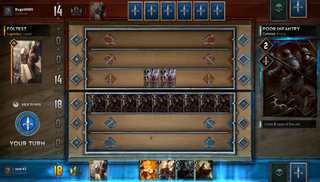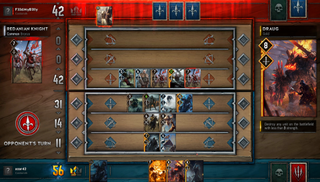Every new thing I learned from the Gwent stress test
New cards, new abilities, and something big: drawing between rounds.
The last time I touched CD Projekt’s Witcher 3 spinoff Gwent was at E3 in June, and even the one measly match I played made it clear how much work had gone into turning Gwent into a competitive game. On top of the completely new interface, there were heaps of new cards and rebalanced versions of old cards I’d won off blacksmiths and barkeeps across the Northern Realms. That taste left me eager for more, so I played as much of Gwent’s ‘kill the servers’ multiplayer stress test today as I could. That turned out to only be about four matches, but I spotted some interesting new cards and mechanics, even in that brief test.
Above is video I captured of two Gwent matches, each played with one of the two premade decks available in the stress test: the Monsters and the Northern Realms. (Sorry about the lower-than-usual audio quality—I didn't realize till afterwards that a new GeForce Experience install had defaulted to recording my webcam mic, so there's some background keyboard clatter and office noise).
Deckbuilding was disabled in the stress test and no other factions were available. I also couldn’t access the store or any other features that will be in the final version of Gwent—it really was just pure player-on-player combat, but my few matches were still filled with new goodies to be excited about.
Unlike most card games, in Gwent you don’t draw a card every time it’s your turn. In The Witcher 3, some specialty cards would let you draw from your deck, and a couple faction leader abilities (a once-per-game use) would let you draw. But CD Projekt has changed this a bit for standalone Gwent. After round one, each player draws two new cards. After round two, I believe each player draws one new card (I only played one three-round match, and didn’t record it).
There are now (at least) three tiers of cards: bronze, silver, and gold. There are also rare, epic, and legendary cards within those tiers, though I don’t know what those terms indicate (whether it’s purely cosmetic, or indicates their scarcity in Gwent’s economy).
Gold cards are special heroes like Geralt, Eredin, Shani, etc, and either possess great strength or special abilities. Like they are in The Witcher 3, they’re immune from most status effects.
Weather effects, which reduce card damage to 1 in a specific row, now specify that they affect non-gold cards. So do most other non-unit cards, like Scorch, which eliminates the strongest non-gold units from the board. Some other cards specifically call out effects they have on bronze cards.
The biggest gaming news, reviews and hardware deals
Keep up to date with the most important stories and the best deals, as picked by the PC Gamer team.
Scorch now has a counterpart called Epidemic, which destroys the weakest non-gold units on the board.

A new card called Promote will turn any bronze or silver card into a gold card. As far as I could tell, upgrading any bronze card to a gold card gave it +2 strength.
Vesemir, Eskel, and Lambert are all 5 or 6 strength cards that will now summon in the other two when played.
Some cards now have a copy ability. In The Witcher 3, many cards (especially in the monster deck) would summon other cards of the same name from your deck onto the board. The Poor Infantry in standalone Gwent works differently. It’s a 2 strength melee card that creates two copies of itself when played. If you have three Poor Infantry cards in your hand, that’s actually going to be nine cards on the board once you’ve played them all. They’re weak, and very vulnerable to Epidemic, but great targets for buff cards.
The Monster faction deck now has a range of Wild Hunt cards that are immune to Frost, the weather effect that reduces melee infantry units to 1 strength. This is notable because they’re mostly bronze cards, which are typically susceptible to weather.
There are now unit cards that cause weather effects. Caranthir is a Monster hero who creates a Frost effect and summons two weak Wild Hunt Hound units onto the board.
There are now unit cards that are buffed by weather effects. The Monster card Ice Giant gains 4 strength when a frost card is in play.
One Monster card, Draug, destroys any unit on the battlefield with less than 3 strength. This card should actually read “3 or less strength,” because when I played it, it wiped the board of 3 strength units, too. (Also, this is a good example of a card that differs from its Witcher 3 version, where it was merely a 10 strength hero card with no special effects).
The Monster card Giant Toad consumes a card in your hand and absorbs its strength, destroying it, but also lets you draw a card. As a result it can be powered up dramatically, but because it’s not a Gold card, this makes it very susceptible to Scorch.

In my brief few matches of Gwent, I saw the potential for a lot more interplay between cards thanks to the new effects I mentioned above. Buffs and debuffs aren’t nearly as simple, and every Hero card has some kind of special ability—destroying other cards, returning cards from your graveyard into play (or stealing one from your opponent’s graveyard), duplicating a card already on the board, and so on. Many familiar cards from the Northern Realms and Monster decks weren’t in this stress test at all, which makes me hopeful that each deck will contain within it the potential for several varied playstyles. That’s vital for a competitive card game to stay fresh.
I played less than an hour of Gwent during the stress test, but what I played was an exciting mix of the familiar and totally new mechanics. I love how much variety they’ve added to the hero cards and hope that’s representative of the entire game. I was actually surprised by how strong a negative reaction I had to the addition of drawing cards between rounds—isn’t that sacrificing the harsh balance of making due with what you have in your hand!?—but I have a hunch that it’s a necessary sacrifice to make Gwent a viable competitive game. In The Witcher 3, there’s a certain satisfying challenge to playing an NPC multiple times and winning against a superior deck by getting a draw that just beats them.
I don’t think that would fly in a PvP game, and drawing more cards offers more opportunity for interplay between units and abilities and special effects. And drawing a couple cards, rather than one card per turn, still makes Gwent a very different game than most Magic the Gathering-inspired CCGs. I think it’s a good sign that every match got me stressed; my stomach was a knot of worry, considering every possible play and counterplay from what I knew of the two decks, and I was anxious about my best-laid plans being upturned with the wrong play. I ended one game by wiping my entire opponent’s board of units except for a lone Geralt, up against a Monster horde. Unlike how that usually goes for Geralt, I handily won the fight.
The full Gwent beta launches on October 25. I’ll be playing more of it then, and hopefully digging into the deckbuilding and everything else tantalizingly locked away in this stress test.

Wes has been covering games and hardware for more than 10 years, first at tech sites like The Wirecutter and Tested before joining the PC Gamer team in 2014. Wes plays a little bit of everything, but he'll always jump at the chance to cover emulation and Japanese games.
When he's not obsessively optimizing and re-optimizing a tangle of conveyor belts in Satisfactory (it's really becoming a problem), he's probably playing a 20-year-old Final Fantasy or some opaque ASCII roguelike. With a focus on writing and editing features, he seeks out personal stories and in-depth histories from the corners of PC gaming and its niche communities. 50% pizza by volume (deep dish, to be specific).
Most Popular

